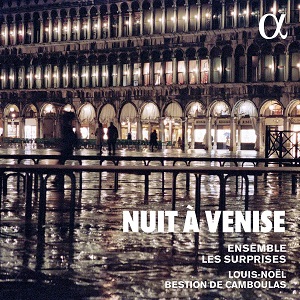
Nuit à Venise
Ensemble Les Surprises/Louis-Noël Bestion de Camboulas
rec. 2022, Abbaye aux Dames, Saintes, France
Texts and translations included
Reviewed as a stereo 16/44 download
Alpha Classics 927 [69]
When I had a first look at the track-list, I was wondering what the programme of this disc was about. The interview with Louis-Noël Bestion de Camboulas clarifies the matter. “With A Night in Venice, I wanted to reimagine a large-scale evening of festivities on the Piazza San Marco and in the Basilica, but also in the gardens and salons of the city’s palaces. Under the arcades we come across musicians playing whirling dance rhythms; further on, a colourful religious procession with singers and instruments intoning a powerful, stirring hymn. As the evening proceeds, we push open the door of a little church at the corner of an alleyway, where three men are chanting part of the biblical Song of Songs, a lyric poem of sensuous sweetness and intimacy. Then along the city canals we hear melodic fragments emerging from the windows of the Doge’s Palace, with a cornetto dialoguing with the voices… So, it’s a night of festive celebration in Venice – mingling the sacred and profane, the intimate and the grandiose, dance and contemplation.”
The question then is: when would that ‘night of festive celebration’ have taken place? The main composer in the programme is Claudio Monteverdi, but it also includes pieces by two composers who had not even been born, when Monteverdi died. If Bestion de Camboulas had stated that he wanted to show the variety of music in Venice during the 17th century, that would not have been a problem, even though that is hardly possible on just one disc. However, this is another typical example of a concept that goes astray because of a lack of discipline on the part of the musical director. If he had set a year somewhere during the lifetime of Monteverdi, he could have found plenty of music to perform.
The balance within the programme between the sacred and the secular is also unsatisfying. Most of the music is sacred; all non-sacred music is instrumental. Monteverdi is represented with two madrigals, but then in sacred contrafacta, a fact that is not mentioned at all in the booklet. The latter includes only an interview with Bestion de Camboulas, but no information on the composers or the music. The documentation in the track-list is poor; fortunately the tags on the disc include some additional information, for instance that Lotti’s setting of the Crucifixus is the one in eight parts. That is important, as he has written a number of them for different scorings. The tags also reveal that the Agnus Dei by Cavalli is taken from his Missa Concertata. Such information needs to be mentioned in the track-list.
Just as the concept of this programme lacks consistency, the performances are uneven. Monteverdi’s Dixit Dominus II is not entirely satisfying, due to the vibrato in some of the high voices. The passage “Tu es sacerdos” is too fast, and sung almost staccato. I don’t see a reason for that, and it is not nice to listen to. The tempi are a bit of a problem here and there. Lotti’s Crucifixus suffers from it, and as a result lacks depth. Monteverdi’s Laudate Dominum I is another example: the contrasts in tempo are exaggerated, and the whole sounds hurried. In Grandi’s O quam tu pulchra es the three voices don’t blend that well. (By the way: Bestion de Camboulas calls Grandi Monteverdi’s friend. He himself may have had a different idea: Monteverdi saw him as a rival and basically prevented Grandi from composing large-scale music for St Mark’s.)
Fortunately, there is also something to enjoy. The instrumental pieces are played very well. As far as the vocal music is concerned, especially the pieces by Giovanni Legrenzi are given fine performances. In recent years I have encountered several discs with his music, and I am quite impressed by the amount of expression in it. He deserves much more interest, and I am happy that he is represented here with some very nice works. Ingemisco is a good example, and Paulin Bündgen sings Oro supplex very well.
On balance, this is a mixed package. The music is of fine quality, but the way the programme has been put together is rather inconsistent. That also goes for the performances. For me the main attraction is the Legrenzi part.
Johan van Veen
www.musica-dei-donum.org
twitter.com/johanvanveen
Help us financially by purchasing from


Contents
Claudio Monteverdi (1567-1643)
Dixit Dominus II (SV 264)
Giovanni Legrenzi (1662-1690)
Sonata VI in e, Op 10,6 (adagio)
Alessandro Grandi (1590-1630)
O quam tu puchra es
Tarquinio Merula (1595-1665)
Ballo detto Eccardo, Op 12,19
Giovanni Antonio Rigatti (1613-1648)
Magnificat
Claudio Monteverdi
Longe mi Jesu (after Parlo, miser, o taccio?, SV 136)
Troppo ben puo (SV 102) (instr)
Pulchrae sunt genae tuae (after Ferir quel petto, Silvio?, pt 5 of Ecco, Silvio, SV 97)
Laudate Dominum I (SV 272)
Giovanni Legrenzi
Ingemisco
Oro supplex
Antonio Lotti (1667-1740)
Crucifixus a 8
Salomone Rossi (c. 1570 – 1630)
Sinfonia grave à 5
Gagliarda detta La Missara
Gagliarda detta La Norsina
Francesco Cavalli (1602-1676)
Missa Concertata:
Agnus Dei
Giovanni Battista Fontana (1589-1630)
Sonata XVI
Giovanni Legrenzi
Salve Regina, Op 7,6
De profundis, Op 9,16


















